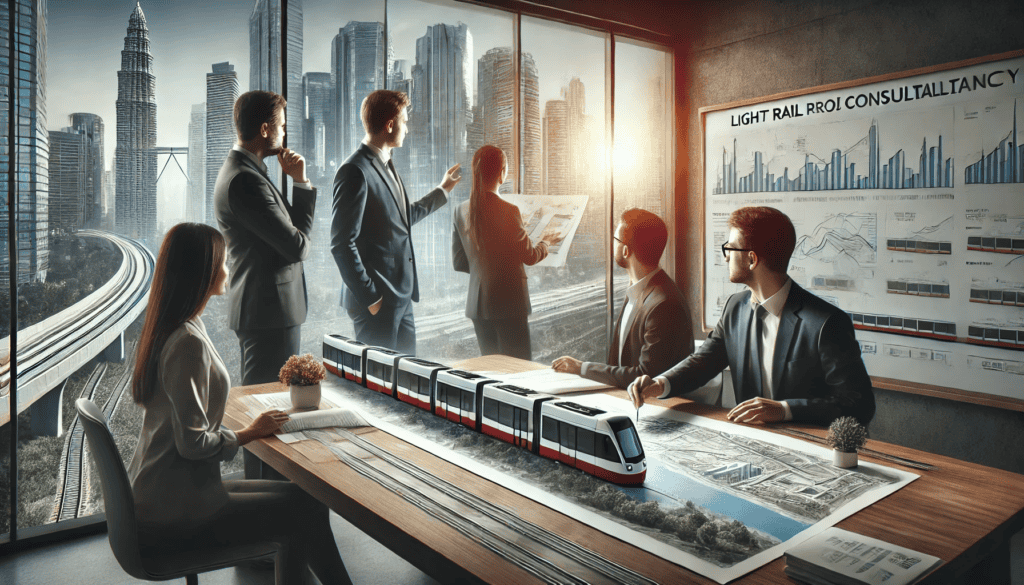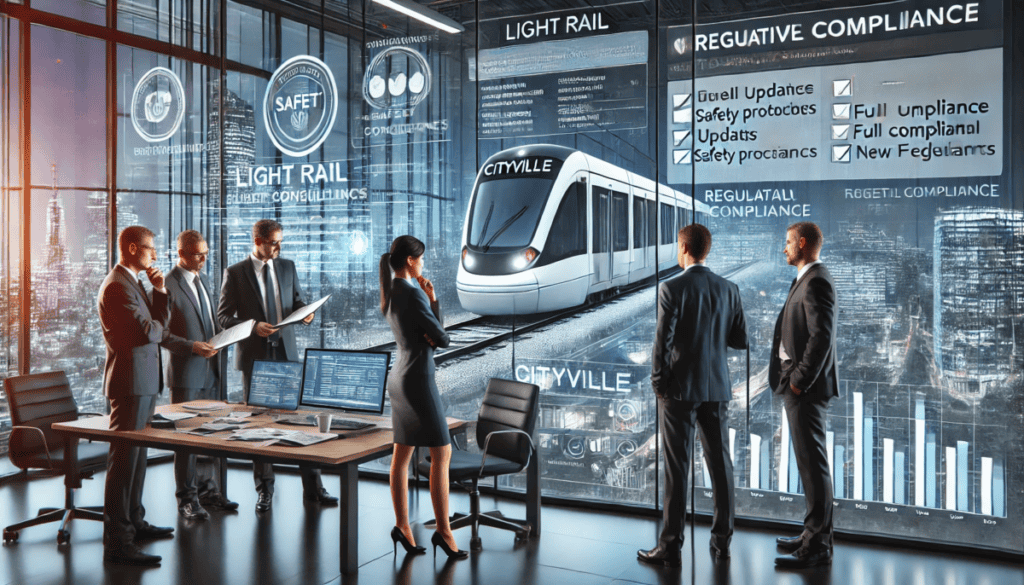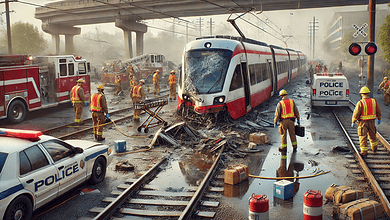Essential Reasons to Hire a Light Rail Consultancy in 2025

Light Rail Consultancy in 2025
The growth of light rail systems in urban areas has been significant in recent years. Cities worldwide are recognizing the advantages of light rail transit (LRT) systems, including reduced traffic congestion, lower environmental impact, and efficient public transportation options.
However, the complexity of planning, implementing, and operating these systems necessitates specialized expertise. This is where hiring a light rail consultancy becomes invaluable.
A light rail consultancy provides essential services to ensure the successful development and operation of light rail systems. From system design to regulatory compliance, these consultancies play a critical role in effectively executing light rail projects.
This article explores the top reasons to hire a light rail consultancy, highlighting their importance and the diverse benefits they offer.
Importance of Light Rail Consultancy
Light rail consultancies are crucial in modern urban transportation for several reasons. They offer specialized services for successfully planning, implementing, and operating light rail systems.
Critical Role in Urban Transportation
Light rail consultancies are integral to the development of urban transportation infrastructure. They provide expert advice on various aspects of light rail systems, including design, construction, operation, and maintenance. By leveraging their expertise, cities can ensure their light rail systems are safe, efficient, and sustainable.
Contribution to Planning, Implementation, and Operation
A light rail consultancy assists in every stage of a light rail project. During the planning phase, they conduct feasibility studies, environmental impact assessments, and financial analyses to determine the project’s viability. During implementation, they oversee construction, manage budgets, and ensure compliance with regulations. Once the system is operational, they provide ongoing support to maintain efficiency and address issues.

Key Benefits and Services Offered
Hiring a light rail consultancy offers numerous benefits and services critical to the success of light rail projects. Here are the top reasons to engage their expertise:
System Design and Planning
One of the primary services light rail consultancies provide is system design and planning. A rail system analysis expert evaluates various factors, including route selection, station placement, and integration with existing transportation networks. This comprehensive analysis ensures that the light rail system is designed for maximum efficiency and passenger convenience.
Designing a light rail system involves considering numerous factors, such as population density, urban development plans, and potential environmental impacts. A light rail consultancy conducts thorough research and collaborates with urban planners, engineers, and local authorities to develop a system that meets the city’s current and future transportation needs.
Safety Assessments and Compliance
Safety is a paramount concern in light rail operations. A light rail safety consultant conducts thorough safety assessments to identify potential risks and develop mitigation strategies. They ensure that the system complies with local and federal safety regulations, reducing the likelihood of accidents and enhancing passenger confidence.
Safety assessments cover various aspects of light rail systems, including track conditions, vehicle maintenance, operator training, and emergency response plans. By regularly conducting these assessments, consultancies help cities maintain high safety standards and protect passengers and operators from potential hazards.
Operational Efficiency and Optimization
Operational efficiency is crucial for the success of a light rail system. A public transit efficiency expert analyzes operational processes to identify areas for improvement. This includes optimizing schedules, improving maintenance routines, and enhancing passenger services. By implementing these recommendations, cities can ensure their light rail systems operate smoothly and efficiently.
Operational efficiency is essential for providing reliable and timely transportation services. A consultancy can help cities develop and implement strategies to minimize delays, reduce operating costs, and improve overall service quality. This not only benefits passengers but also contributes to the sustainability of the light rail system.
Risk Management and Accident Investigation
Accidents and unforeseen events can significantly impact light rail systems. A rail infrastructure expert witness provides expertise in risk management and accident investigation. They analyze incidents to determine causes and recommend preventive measures. Their insights help improve safety protocols and reduce the risk of future accidents.
Risk management involves identifying potential hazards, assessing their likelihood and impact, and developing mitigation strategies. An expert witness can assist cities in implementing comprehensive risk management plans that address various threats, from natural disasters to technical failures.
In the event of an accident, their investigation helps determine liability and provides recommendations to prevent similar incidents.
Regulatory Compliance and Legal Support
Navigating the complex landscape of regulations and legal requirements is challenging. Light rail consultancies offer essential support in ensuring regulatory compliance. They help cities adhere to local, state, and federal laws, avoiding potential legal issues.
In legal disputes, their expertise as a rail infrastructure expert witness is invaluable for providing credible testimony and evidence.
Regulatory compliance is crucial for light rail systems’ legal and safe operation. Consultancies stay up-to-date with the latest regulations and standards, ensuring that cities meet all requirements. They also assist in preparing documentation and reports for regulatory agencies, facilitating smooth approval processes.

Case Studies
To illustrate the value of light rail consultancies, let’s explore some case studies where their services have significantly improved light rail projects.
These case studies serve as theoretical examples to demonstrate potential scenarios and outcomes. While they draw on elements that could be seen in real cases, they remain entirely speculative and are used purely for educational and illustrative purposes.
Example 1: System Design and Planning in Metro City
In Metro City, a light rail consultancy was hired to assist with designing and planning a new light rail system. The consultancy comprehensively analyzed the city’s transportation needs and recommended a route that maximized coverage and minimized costs.
They also advised on the best station locations, ensuring easy access for passengers. As a result, the new light rail system was highly successful, with increased ridership and reduced traffic congestion.
The consultancy’s system design and planning expertise helped Metro City develop a light rail system that effectively addressed the city’s transportation challenges. By carefully selecting routes and station locations, they ensured that the system was convenient for passengers and cost-effective for the city.
Example 2: Safety Assessments in Urbanville
Urbanville’s existing light rail system faced several safety challenges. A light rail safety consultant was brought in for a thorough safety assessment. The consultant identified several critical issues, including outdated signaling equipment and inadequate operator training.
By implementing the consultant’s recommendations, Urbanville significantly improved the safety of its light rail system, leading to fewer accidents and higher passenger confidence.
The consultant’s safety assessment covered all aspects of the light rail system, from track conditions to emergency response plans. By addressing the identified issues, Urbanville enhanced the safety of its light rail operations and protected passengers and operators from potential hazards.
Example 3: Operational Efficiency in Transit City
Transit City’s light rail system experienced frequent delays and service interruptions. A public transit efficiency expert was hired to analyze the system’s operations. The expert identified inefficiencies in scheduling and maintenance practices and recommended several improvements.
Transit City reduced delays and improved service reliability by optimizing schedules and enhancing maintenance routines, resulting in higher passenger satisfaction.
The expert’s analysis of Transit City’s operations revealed several areas for improvement. By implementing the recommended changes, the city was able to provide more reliable and efficient transportation services, benefiting both passengers and the city’s overall transportation network.
Example 4: Risk Management in Railtown
Railtown experienced a serious accident involving its light rail system. A rail infrastructure expert witness was called in to investigate the incident.
The expert conducted a detailed analysis of the accident and identified several contributing factors, including a failure in the signaling system and insufficient safety protocols.
The expert’s recommendations significantly improved Railtown’s safety measures, preventing future accidents and enhancing overall system safety.
The expert witness’s investigation provided valuable insights into the causes of the accident and highlighted areas for improvement in Railtown’s safety protocols.
By implementing these recommendations, the city enhanced the safety of its light rail system and reduced the risk of future incidents.

Example 5: Regulatory Compliance in Cityville
Cityville faced challenges in complying with new federal regulations for light rail systems. A light rail consultancy was hired to provide regulatory compliance support.
The consultancy reviewed Cityville’s policies and procedures and identified areas of non-compliance. They worked with the city to update their safety protocols and training programs, ensuring full compliance with the new regulations.
This proactive approach helped Cityville avoid potential legal issues and maintain the safety and efficiency of its light rail system.
The consultancy’s expertise in regulatory compliance ensured that Cityville met all requirements and maintained its light rail system’s legal and safe operation. The consultancy helped the city navigate the complex regulatory landscape and avoid potential legal challenges by staying up-to-date with the latest regulations and standards.
Example 6: Environmental Impact Assessment in Greentown
Greentown planned to expand its light rail system but was concerned about the environmental impact. A light rail consultancy conducted an environmental impact assessment to evaluate potential effects on local ecosystems and communities.
The consultancy identified mitigation strategies to minimize negative impacts and enhance environmental sustainability. Greentown implemented these strategies, resulting in a project that balanced urban development with environmental preservation.
The environmental impact assessment conducted by the consultancy gave Greentown valuable insights into the potential effects of the light rail expansion. The city minimized negative environmental impacts by implementing the recommended mitigation strategies and promoting sustainable urban development.
Example 7: Financial Analysis in Financetown
Financetown sought to develop a new light rail system but needed to ensure the project’s financial viability. A light rail consultancy conducted a comprehensive financial analysis, including cost estimates, funding options, and projected revenue.
The consultancy provided a detailed financial plan that helped Financetown secure funding and manage project costs effectively. The successful implementation of the financial plan ensured the long-term sustainability of the light rail system.
The consultancy’s financial analysis provided Financetown with a clear understanding of the costs and funding options for the light rail project.
By developing a detailed financial plan, the consultancy helped the city secure the necessary funding and manage project costs effectively, ensuring the long-term sustainability of the light rail system.
Example 8: Community Engagement in Peopleville
Peopleville recognized the importance of community support for its light rail project. A light rail consultancy was hired to facilitate community engagement.
The consultancy organized public meetings, gathered feedback, and addressed community concerns. Their efforts helped build strong community support for the project and ensured its successful implementation.
Community engagement is crucial for the success of public transportation projects. By involving residents in the planning process, the consultancy helped Peopleville gain valuable insights into community needs and preferences, resulting in a light rail system that better served the population.
Example 9: Integration with Other Transit Modes in a Multimodal City
Multimodal City aimed to create an integrated transportation network that included light rail, buses, and bike-sharing services. A light rail consultancy provided expertise in coordinating these different modes of transport.
They developed a comprehensive plan facilitating seamless connections between the light rail system and other transit options, enhancing overall accessibility and convenience for passengers.
Integration with other transit modes is essential for creating efficient and user-friendly transportation networks. The consultancy’s expertise in multimodal transportation planning helped Multimodal City develop a cohesive system that improved connectivity and convenience for passengers.
Example 10: Technological Innovation in Future City
Future City wanted to incorporate cutting-edge technology into its light rail system. A light rail consultancy advised on the latest advancements in transportation technology, such as automated train control, real-time passenger information systems, and sustainable energy solutions.
By implementing these innovations, Future City created a modern and efficient light rail system that set new standards for urban transportation.
Technological innovation plays a vital role in enhancing the efficiency and sustainability of light rail systems. The consultancy’s knowledge of the latest advancements in transportation technology helped Future City develop a state-of-the-art system that improved service quality and passenger experience.

Positive Impact of a Light Rail Consultant
Hiring a light rail consultancy offers numerous critical benefits for successfully planning, implementing, and operating light rail systems.
These consultancies provide essential services, including system design and planning, safety assessments, operational efficiency optimization, risk management, and regulatory compliance support. Their expertise ensures that light rail systems are safe, efficient, and sustainable.
The real-world examples highlighted in this article demonstrate the significant positive impact that light rail consultancies can have on urban transportation projects.
By leveraging their specialized knowledge and experience, cities can overcome challenges, improve their light rail systems, and provide better public transportation options for their residents.

